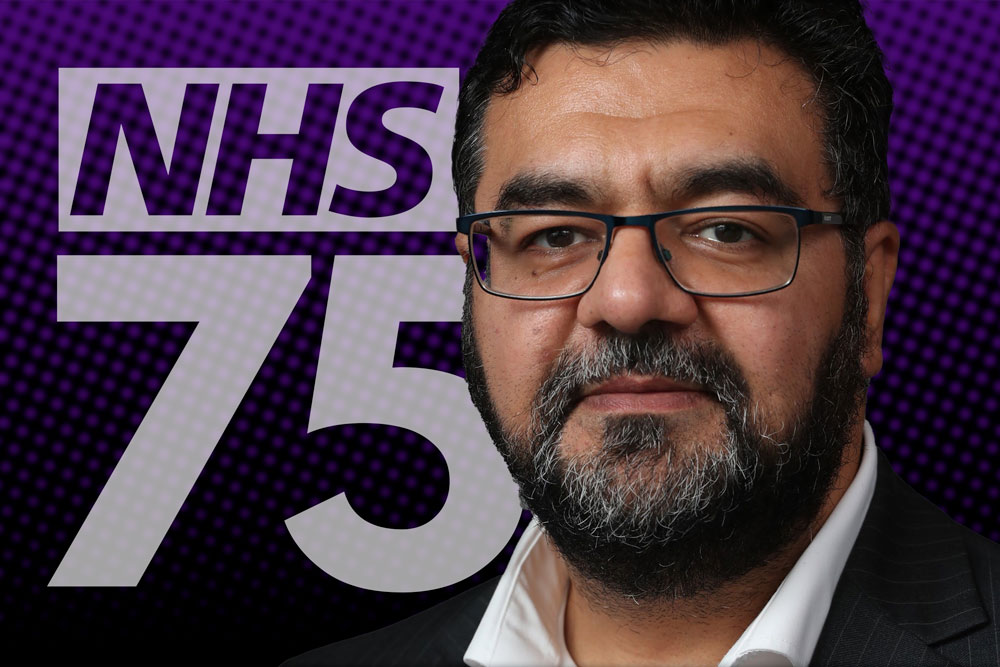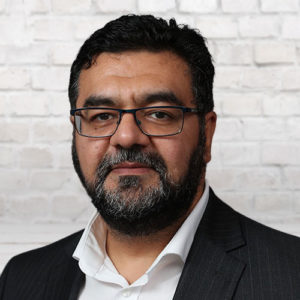As the NHS celebrates its 75th anniversary, Dr Rizwan Malik, consultant NHS radiologist & director of SMR Health Tech Consultancy and member of the Highland Marketing advisory board, reflects on the impact of IT on the health service and his own speciality of radiology. He also considers how digital technology can help to address the challenges that the health service faces, as it looks forward.
Seventy-five is a significant milestone. What are your personal thoughts and feelings about the NHS turning 75?
Personally, I think it is an incredible achievement. I think it is a mark of a decent, civilised society that we can still maintain the three principles of the NHS, whereby we provide a service that helps everyone, is free [at the point of delivery], and based on need, rather than the ability to pay.
You look at other Western societies around us, some of which are crippled by fear of having to access healthcare services because people can’t afford them, I think it is right and proper that we maintain these principles.
How has the advancement of health technology and digital health transformed the NHS – and what changes have you witnessed firsthand?
It has changed, not quite beyond all recognition, but significantly, even during the course of my clinical practice. I qualified in 1998, and I think it would be reasonable to say that [in that time there has been] a transition from an analogue to a digital era.
If we look just at my own speciality, for example, we had a few bulky X-ray machines and CT scanners, while MR was very much the preserve of research at high-end academic institutes. Now, every single district general hospital should have access to them.
Imaging was undertaken at specific sites. Films were printed and they had to be viewed on viewing boxes. Now, this is all digitised [which means] you can disassociate where an image is undertaken from where it can be viewed. We [no longer have to] go into a hospital, into a specific building, and onto specific equipment, to be able to report what we do.
This federated approach is far more convenient for the society we live in now, in which patients have more choice about where healthcare is provided, and clinicians can do outreach into the types of care they provide.
A good example is that we have ultrasound provided either significantly or wholly in the community, and even at GP surgeries. We also have MR scanning vans and CT scanning vans and X-ray scanning vans based in hospital and supermarket car parks to make it easier for our patients to access diagnostic services.
[These developments have also changed the nature of clinical practice]. When I started, it was mainly based on the healing hands of the physician: on clinical examination. Diagnostic tests were very much the purview of the few and the privileged and now that has changed entirely, and quite rightly so.
The practice of medicine becomes safer and safer, the more we can leverage better and more advanced health technologies into the care of our patients.
What technologies do you envision as game-changers for the NHS in its next 75 years?
It would be foolish to speculate what healthcare delivery will look like in 75 years’ time. It has changed almost beyond all recognition [since the NHS was founded] – although I notice we have still not lost the stethoscope as a symbol of healthcare delivery, even now.
Going forward, we will clearly have more and more in-reach of digital technologies, more and more automation, more and more self-care. [There will be] more use of mobile technologies that patients can use to access the information that they need to take more ownership of the healthcare that is available to them, without having to access specific individuals or specific institutions.
[Expertise can then be used for] conditions that patients cannot manage themselves, or that cannot be managed at home. By doing this, what we will hopefully be doing is promoting a healthier society, in which healthcare is more in tune with prevention; and delivery of interventions is more by way of exception than the norm.
It would, perhaps, also feed into empowering society to take more ownership of health and wellness. Although, to do that, we will need to give individuals the tools to do it. The other aspect, of course, is that when we have society growing [and ageing], the relative proportion of people who need access to healthcare grows, so we need to change the way we deliver healthcare, to make it more efficient.
We need to make sure that the services, the tools, the software, the equipment that we use are more joined up, more efficient, more collaborative, so we don’t have multiple silos [of care], and people having to transfer from one to the other. We need everything to be more seamless.
We also need to make sure there is a single point of visibility in the patient’s record for all aspects of the care that is being delivered to them. Hopefully, we are starting to see the dawn of this right now, and over the next five-year cycle, we should start to see the layering in of automation.
There is also the issue of data, in which the NHS is drowning – both within the traditional structures of the healthcare system but also, increasingly, from the community from people who use wearable technology.
Unfortunately, we are not yet in a position to use this data effectively to improve healthcare and perhaps that needs to be a focus; particularly if we want to empower patients to take more ownership of their health and treatment options.
We need to work out how to incorporate patient-generated data into other data sources, and how to weave this multi-source data into a patient-centric view. In other words, we need to pivot from looking at it through an illness lens and instead take a “person-centric” perspective to seize the opportunity for the live management of wellbeing.
The NHS has been absolutely pioneering in its use of artificial intelligence technologies, in imaging in particular, and we can hope to extend the scope of this going forward. It is reassuring to see this is an ambition for the government and political parties across the board.
From there, perhaps, we can start to see a transition to a more and more collaborative, less proprietary, more interoperable [form of] software delivery. One that can be embedded using the principles of need rather than who can afford it. It is all about breaking down silos and making better use of technology for the benefit of all.
Ironically, I think in this regard, we can learn a lot from resource-poor countries. In sub-Saharan Africa, or the far-East, or even the Indian sub-continent, there aren’t enough doctors, so they have had to rely on health tech and digitisation to make sure patients have some semblance of healthcare delivery in a timely and effective manner.
I think, rather than thinking we always have to export, there is a lot we can ingest from these countries that have had to learn how we can deliver healthcare in a very different manner.
The NHS is, of course, facing significant challenges. In your opinion, what are the greatest hurdles to overcome, and how can the NHS effectively tackle these challenges? Where might health technology and digital health fit?
The core one is that society is ageing and society is growing. So, the demand and capacity mismatch is growing more and more burdensome by the day. [At the same time] technology is continuing to develop at pace, and the more we learn the more we can do.
In the past, we were often limited by what we could do: by the treatments that were available to us. For example, there was an era when the treatment for heart attack was bedrest! Now we can intervene far more effectively in multiple different ways, but all these things cost.
So, how can we counter this? Well, the first thing, of course, is to leverage digital technology as much as we are able, to make the processes that we undertake are as efficient and effective as possible. This means reducing or removing monotonous tasks that can be automated, so we enable our human operators to use their brains and use their time on the things that cannot be made robotic.
Our workflows also need to be made more efficient. Simply passing [patients] from one part of the system to another needs to be made more efficient [or eliminated when it is happening] just because the system [requires it]. As I mentioned earlier, we also need increasing use of health tech to enable patients to take ownership of their personal health.
And, perhaps, to promote a healthier society, in which there is better eating, better quality of exercise, and we can start moving towards a better, more preventative service. But, at some point, I suspect, we are going to come to a crunch point; not so much a limit on what we can do, but on what we can afford, or perhaps on the capacity of who we can do it for.
Again, I take this back to the founding principles of the NHS. Perhaps there will be a time, sooner or later, where we have to ask whether we do still want the principle of free healthcare for our society. I would suggest the answer is yes, absolutely, yes.
But what is it that we can afford, and how can we target our resources more effectively towards those needs? [Because we want to] make sure that we don’t ever get to the point where people don’t access the healthcare that they need, particularly for life and limb scenarios, because they fear the consequences of affording it, as we have seen in other countries in the Western world.
Dr Rizwan Malik is a consultant radiologist with a dedicated interest in health tech, digital imaging and AI. He provides consultancy services via South Manchester Radiology and was previously divisional medical director at the Royal Bolton Hospital and president of the UKIO.
Rizwan is a member of the Highland Marketing advisory board, which advises the specialist health tech agency and its clients on developments in digital health and effective PR, marketing and communications for the industry.



